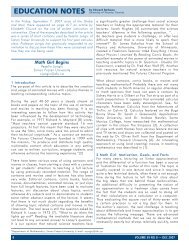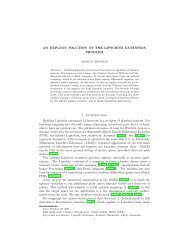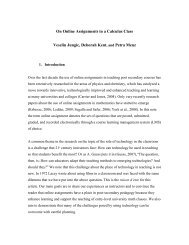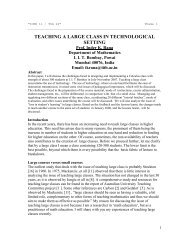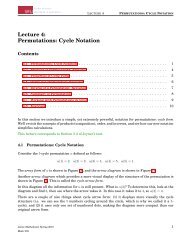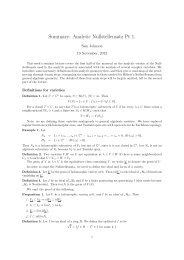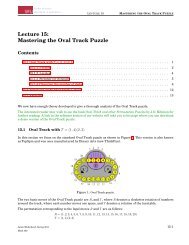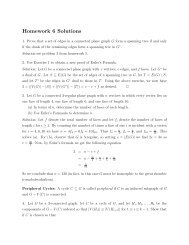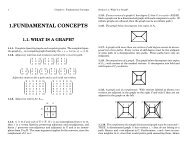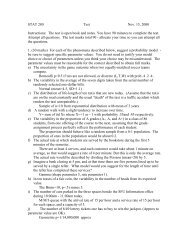1.2. PATHS, CYCLES, AND TRAILS - People.stat.sfu.ca
1.2. PATHS, CYCLES, AND TRAILS - People.stat.sfu.ca
1.2. PATHS, CYCLES, AND TRAILS - People.stat.sfu.ca
You also want an ePaper? Increase the reach of your titles
YUMPU automatically turns print PDFs into web optimized ePapers that Google loves.
27 Chapter 1: Fundamental Concepts Section 1.2: Paths, Cycles, and Trails 28<br />
u ∈ S and v /∈ S. Now there is an x, v-path formed by extending an x, upath<br />
along the edge uv. This contradicts the choice of S, so in fact S is all<br />
of V (G). Since there are paths from x to all other vertices, the transitivity<br />
of the connection relation implies that G is connected.<br />
<strong>1.2.</strong>23. a) If a connected simple graph G is not a complete graph, then every<br />
vertex of G belongs to some induced subgraph isomorphic to P3. Let v be a<br />
vertex of G. If the neighborhood of v is not a clique, then v has a pair x, y<br />
of nonadjacent neighbors; {x, v, y} induces P3. If the neighborhood of v is a<br />
clique, then since G is not complete there is some vertex y outside the set S<br />
consisting of v and its neighbors. Since G is connected, there is some edge<br />
between a neighbor w of v and a vertex x that is not a neighbor of v. Now<br />
the set {v, w, x} induces P3, since x is not a neighbor of v.<br />
One <strong>ca</strong>n also use <strong>ca</strong>ses according to whether v is adjacent to all other<br />
vertices or not. The two <strong>ca</strong>ses are similar to those above.<br />
b) When a connected simple graph G is not a complete graph, G may<br />
have edges that belong to no induced subgraph isomorphic to P3. In the<br />
graph below, e lies in no such subgraph.<br />
•<br />
e<br />
•<br />
• •<br />
<strong>1.2.</strong>24. If a simple graph with no isolated vertices has no induced subgraph<br />
with exactly two edges, then it is a complete graph. Let G be such a graph.<br />
If G is disconnected, then edges from two components yield four vertices<br />
that induce a subgraph with two edges. If G is connected and not complete,<br />
then G has nonadjacent vertices x and y. Let Q be a shortest x, y-path; it<br />
has length at least 2. Any three successive vertices on Q induce P3, with<br />
two edges.<br />
Alternatively, one <strong>ca</strong>n use proof by contradiction. If G is not complete,<br />
then G has two nonadjacent vertices. Considering several <strong>ca</strong>ses (common<br />
neighbor or not, etc.) always yields an induced subgraph with two edges.<br />
<strong>1.2.</strong>25. Inductive proof that every graph G with no odd cycles is bipartite.<br />
Proof 1 (induction on e(G)). Basis step (e(G) = 0): Every graph with<br />
no edges is bipartite, using any two sets covering V (G).<br />
Induction step (e(G) > 0): Dis<strong>ca</strong>rding an edge e introduces no odd<br />
cycles. Thus the induction hypothesis implies that G − e is bipartite.<br />
If e is a cut-edge, then combining bipartitions of the components of<br />
G − e so that the endpoints of e are in opposite sets produces a bipartition<br />
of G. If e is not a cut-edge of G, then let u and v be its endpoints, and let<br />
X, Y be a bipartition of G − e. Adding e completes a cycle with a u, v-path<br />
in G − e; by hypothesis, this cycle has even length. This forces u and v to be<br />
in opposite sets in the bipartition X, Y . Hence the bipartition X, Y of G − e<br />
is also a bipartition of G.<br />
Proof 2 (induction on n(G)). Basis step (n(G) = 1): A graph with one<br />
vertex and no odd cycles has no loop and hence no edge and is bipartite.<br />
Induction step (n(G) > 1): When we dis<strong>ca</strong>rd a vertex v, we introduce<br />
no odd cycles. Thus the induction hypothesis implies that G −v is bipartite.<br />
Let G1, . . . , Gk be the components of G − v; each has a bipartition. If v has<br />
neighbors u, w in both parts of the bipartition of Gi, then the edges uv and<br />
vw and a shortest u, w-path in Gi form a cycle of odd length. Hence we <strong>ca</strong>n<br />
specify the bipartition Xi, Yi of Gi so that Xi contains all neighbors of v in<br />
Gi. We now have a bipartition of G by letting X = Xi and Y = {v}∪( Yi).<br />
<strong>1.2.</strong>26. A graph G is bipartite if and only if for every subgraph H of G,<br />
there is an independent set containing at least half of the vertices of H.<br />
Every bipartite graph has a vertex partition into two independent sets, one<br />
of which must contain at least half the vertices (though it need not be a<br />
maximum independent set). Since every subgraph of a bipartite graph is<br />
bipartite, the argument applies to all subgraphs of a bipartite graph, and<br />
the condition is necessary.<br />
For the converse, suppose that G is not bipartite. By the characterization<br />
of bipartite graphs, G contains an odd cycle H. This subgraph H<br />
has no independent set containing at least half its vertices, be<strong>ca</strong>use every<br />
set consisting of at least half the vertices in an odd cycle must have two<br />
consecutive vertices on the cycle.<br />
<strong>1.2.</strong>27. The “transposition graph” on permutations of [n] is bipartite. The<br />
partite sets are determined by the parity of the number of pairs i, j such<br />
that i < j and ai > aj (these are <strong>ca</strong>lled inversions). We claim that each<br />
transposition changes the parity of the number of inversions, and therefore<br />
each edge in the graph joins vertices with opposite parity. Thus the<br />
permutations with an even number of inversions form an independent set,<br />
as do those with an odd number of inversions. This is a bipartition, and<br />
thus the graph is bipartite.<br />
Consider the transposition that interchanges the elements in position<br />
r and position s, with r < s. No pairs involving elements that are before r<br />
or after s have their order changed. If r < k < s, then interchanging ar and<br />
as changes the order of ar and ak, and also it changes the order of ak and as.<br />
Thus for each such k the number of inversions changes twice and retains<br />
the same parity. This describes all changes in order except for the switch<br />
of ar and as itself. Thus the total number of changes is odd, and the parity<br />
of the number of inversions changes.



